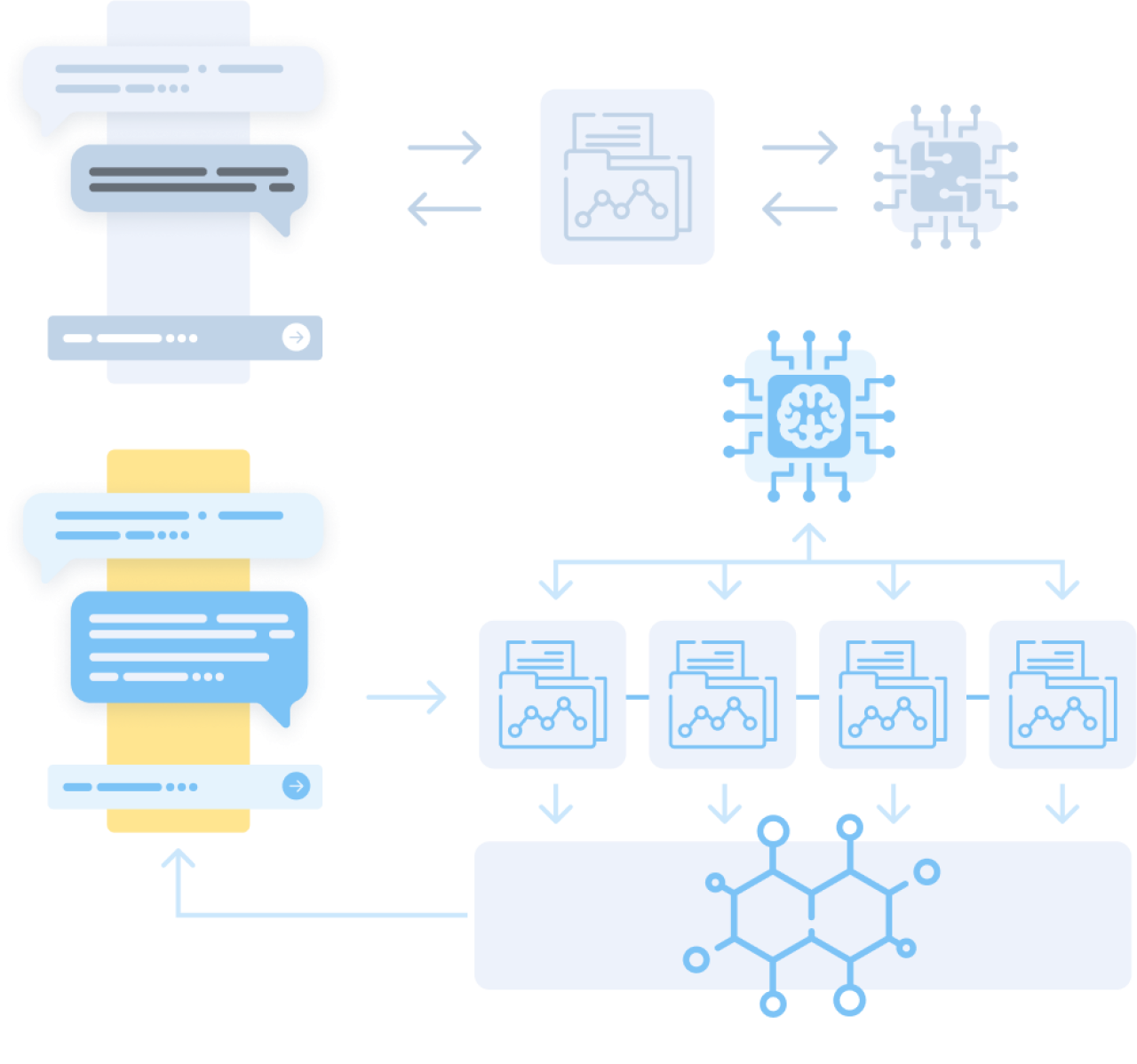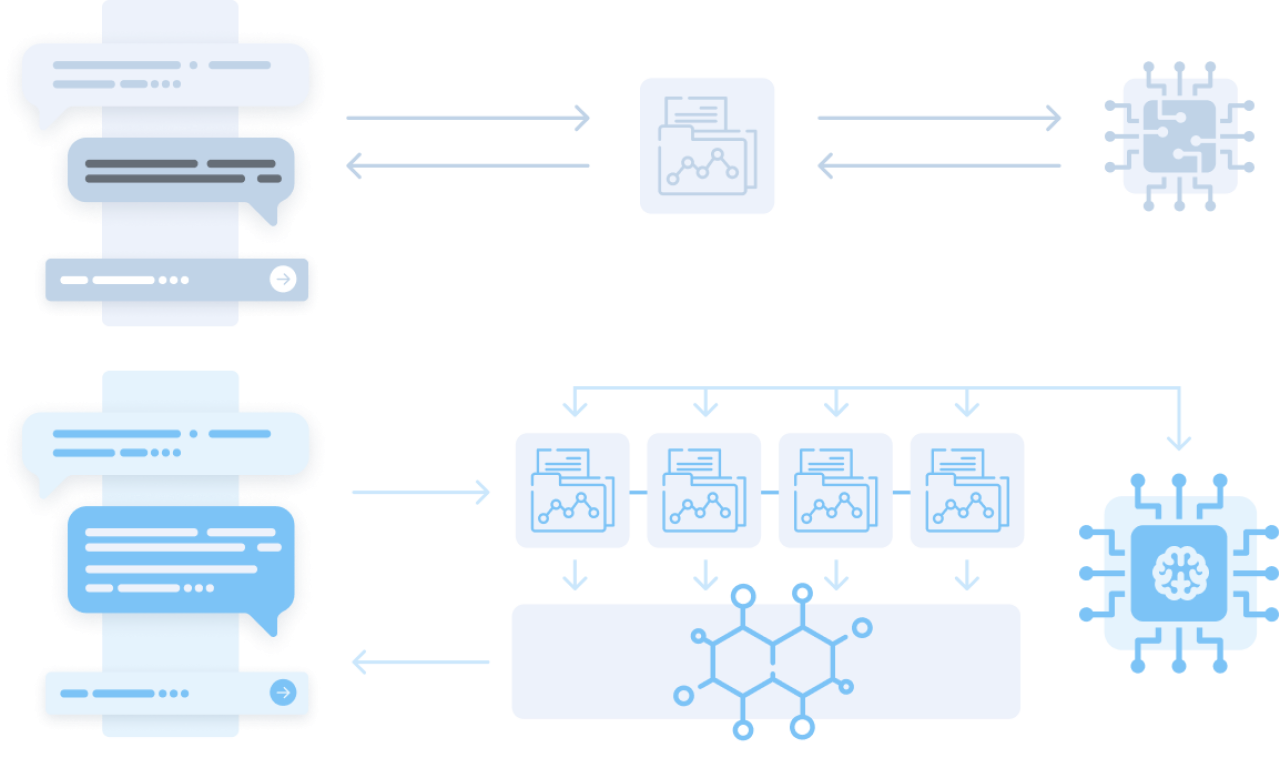























Apr 18, 2024

Bryon Jacob
CTO & Co-Founder

You may be curious about how artificial intelligence, with its complex capabilities, can meet your enterprise needs. The answer lies in one term: Agents. This article aims to elucidate the intricate relationship between artificial intelligence (AI) and enterprise needs. We will start by explaining the fundamental concepts and gradually navigate through the complex world of AI agents.
An AI agent is a digital assistant that perceives its environment and takes actions to achieve specific objectives. In simpler terms, an agent is a system that senses its surroundings and acts accordingly. For instance, a thermostat is an agent that senses the temperature and adjusts it to maintain a comfortable environment. This sensing and acting mechanism is the foundation of interactive AI. However, an AI agent is more advanced than a simple agent like a thermostat. It has the added ability to understand context and make choices.
Chatbots are often our first encounter with AI agents. These digital entities communicate with us, understand our requests, and provide solutions. They function by sensing (receiving our messages) and acting (providing responses), which aligns with the basic framework of an AI agent. This interaction, while seemingly simple, is a significant milestone in the evolution of AI, leading the way for more advanced AI agency. It's important to note that chatbots are not just large language models (LLMs). They are complex systems with multiple internal states, each of which can use a variety of techniques including deterministic algorithms and statistical ones like LLMs.
Large Language Models, such as GPTs, are deep-learning models that have been trained on vast amounts of natural language data. They have the ability to predict the next tokens in a sequence of natural language in unique ways, which closely approximates the ability to "speak" the language they were trained on and express an "understanding" of the concepts covered in those materials. However, their capabilities are entirely confined to text processing. Despite their ability to produce complex outputs, they lack the ability to perform broader real-world actions or decision-making, distinguishing them from more advanced AI agents.
In an enterprise setting, the demands are more complex than simple Q&A. Businesses need agents that can navigate vast data landscapes, from sales analytics to operational insights, with precision and context-awareness. Just as humans extend their capabilities with external tools, from a simple calculator or notebook to an advanced enterprise data store, AI agents also need to be equipped with the right tools. This is where the concept of "orchestrating" comes into play. Orchestrating involves coordinating and managing the various components of an AI agent to ensure they work together effectively.
Consider an AI agent proficient at analyzing sales trends and consolidating product usage data. These tasks go beyond the capabilities of a standalone LLM; they necessitate a more advanced, multi-stage agent. Such an agent would have a multi-step process, represented in a state machine or process flow, to accomplish its tasks. The real power lies in using LLMs at these individual steps to accomplish sub-goals, check progress, and cross-reference the tasks carried out with AI with governed data sources. This approach mirrors how humans work - breaking tasks into smaller tasks, planning, strategizing, and bringing the parts together into a complete answer. A single interaction with such an agent could well involve many LLM interactions, almost an "inner dialogue" of the agent.
This advanced agent, while utilizing the linguistic capabilities of LLMs, is not limited to them. It’s equipped with a broader set of skills: accessing and analyzing structured data, interacting with enterprise-specific knowledge graphs, and executing actions based on intricate data-driven insights. It's a combination of LLMs’ proficiency in language understanding and the strategic, multi-layered approach required for enterprise operations.

The transition from LLMs to multi-step enterprise agents represents the evolution from simple linguistic tasks to complex, goal-oriented initiatives. While LLMs provide the foundation for understanding and generating language, the multi-step agents use this skill as one among many. They embody the strategic planning, extensive data access, and contextual understanding that enterprises demand.
By merging the nuanced text interpretation of LLMs with the broader, goal-driven capabilities of advanced agents, businesses can unlock a new level of efficiency and insight. This fusion of simplicity in language processing with complexity in action and planning characterizes the next wave of AI in the enterprise domain.
Understanding the transition from basic language models to sophisticated enterprise agents is crucial for businesses to fully leverage the world-changing potential of AI. The journey from simple text responses to complex, data-driven decision-making is a significant leap in our pursuit of intelligent, responsive, and effective AI solutions.

You may be curious about how artificial intelligence, with its complex capabilities, can meet your enterprise needs. The answer lies in one term: Agents. This article aims to elucidate the intricate relationship between artificial intelligence (AI) and enterprise needs. We will start by explaining the fundamental concepts and gradually navigate through the complex world of AI agents.
An AI agent is a digital assistant that perceives its environment and takes actions to achieve specific objectives. In simpler terms, an agent is a system that senses its surroundings and acts accordingly. For instance, a thermostat is an agent that senses the temperature and adjusts it to maintain a comfortable environment. This sensing and acting mechanism is the foundation of interactive AI. However, an AI agent is more advanced than a simple agent like a thermostat. It has the added ability to understand context and make choices.
Chatbots are often our first encounter with AI agents. These digital entities communicate with us, understand our requests, and provide solutions. They function by sensing (receiving our messages) and acting (providing responses), which aligns with the basic framework of an AI agent. This interaction, while seemingly simple, is a significant milestone in the evolution of AI, leading the way for more advanced AI agency. It's important to note that chatbots are not just large language models (LLMs). They are complex systems with multiple internal states, each of which can use a variety of techniques including deterministic algorithms and statistical ones like LLMs.
Large Language Models, such as GPTs, are deep-learning models that have been trained on vast amounts of natural language data. They have the ability to predict the next tokens in a sequence of natural language in unique ways, which closely approximates the ability to "speak" the language they were trained on and express an "understanding" of the concepts covered in those materials. However, their capabilities are entirely confined to text processing. Despite their ability to produce complex outputs, they lack the ability to perform broader real-world actions or decision-making, distinguishing them from more advanced AI agents.
In an enterprise setting, the demands are more complex than simple Q&A. Businesses need agents that can navigate vast data landscapes, from sales analytics to operational insights, with precision and context-awareness. Just as humans extend their capabilities with external tools, from a simple calculator or notebook to an advanced enterprise data store, AI agents also need to be equipped with the right tools. This is where the concept of "orchestrating" comes into play. Orchestrating involves coordinating and managing the various components of an AI agent to ensure they work together effectively.
Consider an AI agent proficient at analyzing sales trends and consolidating product usage data. These tasks go beyond the capabilities of a standalone LLM; they necessitate a more advanced, multi-stage agent. Such an agent would have a multi-step process, represented in a state machine or process flow, to accomplish its tasks. The real power lies in using LLMs at these individual steps to accomplish sub-goals, check progress, and cross-reference the tasks carried out with AI with governed data sources. This approach mirrors how humans work - breaking tasks into smaller tasks, planning, strategizing, and bringing the parts together into a complete answer. A single interaction with such an agent could well involve many LLM interactions, almost an "inner dialogue" of the agent.
This advanced agent, while utilizing the linguistic capabilities of LLMs, is not limited to them. It’s equipped with a broader set of skills: accessing and analyzing structured data, interacting with enterprise-specific knowledge graphs, and executing actions based on intricate data-driven insights. It's a combination of LLMs’ proficiency in language understanding and the strategic, multi-layered approach required for enterprise operations.

The transition from LLMs to multi-step enterprise agents represents the evolution from simple linguistic tasks to complex, goal-oriented initiatives. While LLMs provide the foundation for understanding and generating language, the multi-step agents use this skill as one among many. They embody the strategic planning, extensive data access, and contextual understanding that enterprises demand.
By merging the nuanced text interpretation of LLMs with the broader, goal-driven capabilities of advanced agents, businesses can unlock a new level of efficiency and insight. This fusion of simplicity in language processing with complexity in action and planning characterizes the next wave of AI in the enterprise domain.
Understanding the transition from basic language models to sophisticated enterprise agents is crucial for businesses to fully leverage the world-changing potential of AI. The journey from simple text responses to complex, data-driven decision-making is a significant leap in our pursuit of intelligent, responsive, and effective AI solutions.
Get the best practices, insights, upcoming events & learn about data.world products.